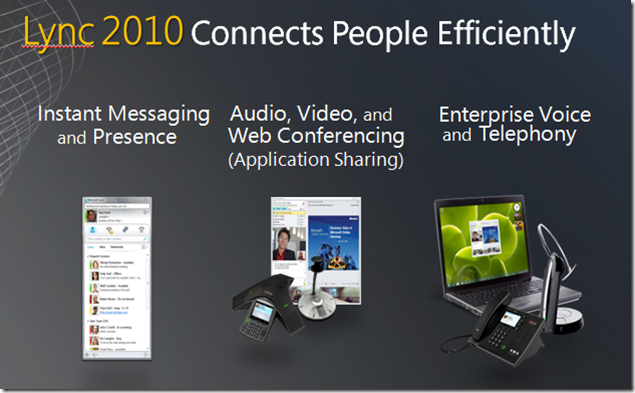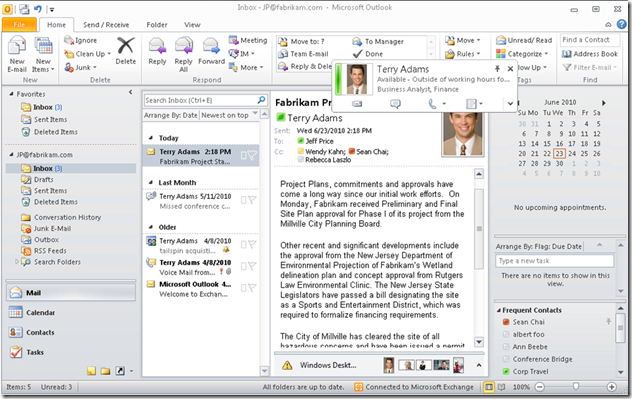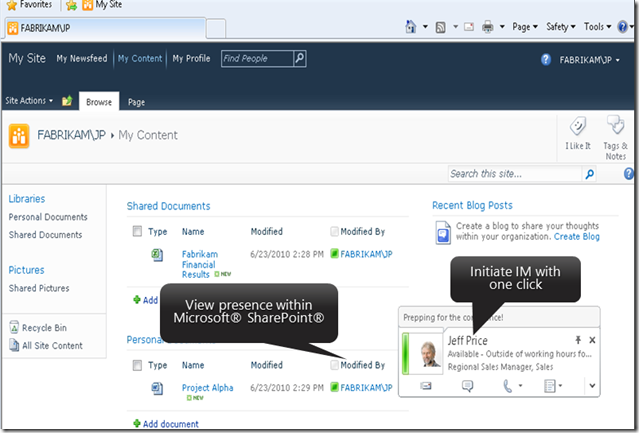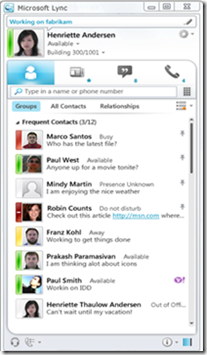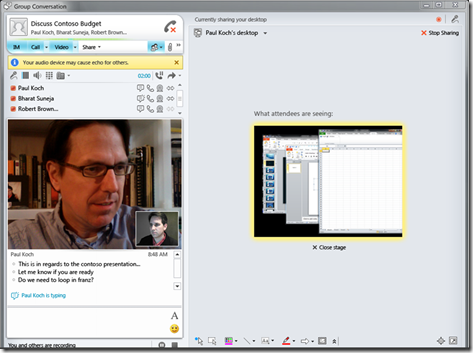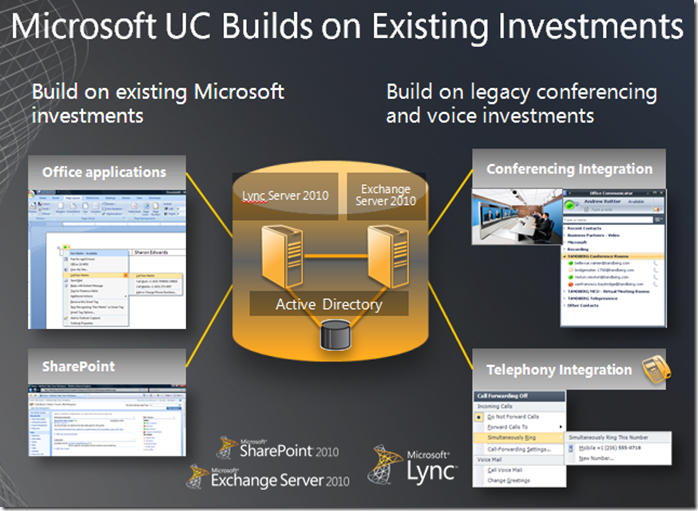The Unified Communications Customer Conversation for SMB, Part 3: Lync, the special sauce
Hopefully, by now we’ve laid the foundation of why a customer should be interested in UC in general, as well as why they should specifically be interested in the Microsoft UC&C solution in particular.
Before moving to our Lync discussion, let me again highlight a couple of key online resources that you’ll want to know about and leverage:
- The Future of Productivity Starts Here home page
- The Lync home page on Microsoft.com
- Lync product information on the Microsoft U.S. partner portal
And, btw, in case you’re not up to speed on Lync, it’s basically the next generation of our Office Communications Server (OCS) product line, although it incorporates the conferencing functions previously done by Live Meeting which represents a major enhancement in our UC solution story.
We saw at the end of the last installment that the Microsoft UC&C stack brings together all the components over the single unified, efficient infrastructure which is Active Directory (and which can be synchronized with BPOS/Office 365). The graphic below outlines the “workloads” that Lync 2010 brings to the table (presence, secure enterprise IM, A/V conferencing, and voice/telephony) – and it should be noted that it does this via a single integrated client (Lync client).
As we pointed out in the last session, it’s quite unlikely that your customer is currently able to leverage IM, conferencing, and voice all in a single client app; not to mention all the potential extra infrastructure effort required on the back-end for implementing and maintaining these workloads. What’s interesting to note here is that even though Lync represents a highly unified client for these workloads, in many, if not most, cases, the end user will never even have to launch the Lync client as those workloads can all be accessed from the presence icon within an email in Outlook or on a SharePoint page – if you’ve never seen this demonstrated, it’s a WOW demo (from within an email you can show how presence streamlines the comm process, then in a single click go to any one of the possible comm mediums, e.g. one click to start an IM if they’re showing online, one click to reply by email if they’re showing offline or busy. It’s also just one click to start (or escalate an existing chat/conversation) to either voice call, video conference, or application/desktop share, again, all this from right inside Outlook, never having to launch or log into a separate app. Of course, the same thing applies if you leverage presence in SharePoint, so if I have a question about a document I just saw on SharePoint, I can easily and efficiently determine who the best (and most available) resource is and initiate contact with them in any of a number of modes literally instantaneously. I guarantee a demo like that will get the attention of most BDMs and TDMs that aren’t already enjoying that level of integration and productivity today. Here’s a couple of screenshots that show the mail and SharePoint integration as well as the new Lync client.
The graphic above shows the mini-contact card that appears when I hover over a mail recipient – you can use that to initiate (with one click) the most efficient communications mode based on the status (presence) of the recipient. In this case, since Terry appears to be online, I would most likely click the second icon from the left which would start an IM conversation. Or I could click the phone receiver icon to initiate a voice call which could simultaneously ring all of the contact numbers Terry allows, including his cell. Or if he was offline or busy, I could click the leftmost icon which would start an email reply. The graphic below shows the same integrated presence and contact card options viewed from a SharePoint page. If I had a question about the change Jeff made to the Project Alpha document, this would greatly facilitate and streamline that follow-up communication. Also, as a side note, you should note that SharePoint gives me ability to see who last modified, or who is associated with a document, and, in fact, it would have proactively notified me that a change had been made if I had “subscribed” to that site or doc.
And below is a shot of the new Lync client; it has a significant number of enhancements over the previous (Communicator) client, including it’s ability to be the conferencing client (so you no longer need to launch a separate Live Meeting client).
This graphic below highlights some of the key benefits and selling points of the Microsoft UC solution. In previous paragraphs we discussed how Microsoft UC brings a level of converged communications to the table that is unmatched in the industry (to my knowledge). You can access many case studies as well as the Forrester TEI whitepaper to get more specific cost reduction data, but it should be obvious on face value that implementing all these workloads in such a highly integrated fashion and leveraging AD should bring your customer significant infrastructure and integration savings (the stuff that they’re paying for with the presumably “free” solutions) – just the integration of the client piece alone might be substantial, which brings us to the next point, quick adoption. The quick adoption aspect is huge, getting more out of the Office, that they likely already have and are familiar with, as well as the efficiency of not having to use multiple different logins or UIs to for IM, mail, conferencing, and voice mail is something no other UC solution is going to offer. And last, but not least, is the deployment flexibility they can leverage to implement this either as an on-premise or online solution, or any combination of the two, again, no other solution will bring that to the table. If your SMB customer is a small business, even if they already have Exchange implemented as an on-premise solution, say with SBS, they can easily add on the UC and Collaboration pieces, either as stand-alone online solutions or as a bundle with Office 365, and have it all working together literally today – that’s one of the great things about cloud services. Of course there will be integration services that you, the partner will need to be ready to provide around this, but that’s generally the high margin revenue most of you want.
The graphic below depicts the (AD) integration we’ve been discussing and it also highlights several other key messages to keep in mind when having the customer conversation around UC. The Microsoft UC solution will, more than any other 3rd-party solution, build on the existing investments they may already have in the Microsoft platform – things like deep Outlook/Office app and SharePoint integration, that I’ve discussed above. I mentioned the major enhancement that incorporating the Live Meeting conferencing workloads into Lync represents, but what I haven’t mentioned up to now is that Lync also is a serious step up the voice and telephony workload technology ladder, to the extent that Lync is now a capable PBX replacement option. Yet, because it’s software, there’s no particular need to rip-and-replace existing PBXs, it will likely interoperate with and extend an existing PBX (although I should note that this is will likely require expertise and even additional infrastructure to accommodate, e.g. gateways and/or SIP trunking solutions).
So there you have it, there’s so much more that I could discuss around our UC&C solution, but folks have written entire books on it and that’s not my charter here. I hope, now, you have at least some thoughts and why and how you should be having customer conversations around this great opportunity, not only for you customer but for you, their Microsoft partner, as well. And don’t forget or miss the fact that being able to add all this onto their existing business messaging and collaboration environment via Office 365, or stand-alone Lync Online options, with no upfront investment in infrastructure or in-house expertise means that SMBs now can have the potential to level the field, UC-wise, with the enterprises of the world or even their own business partners.
Before I sign off, here’s an interesting video (that I found on the “Productivity Starts Here” site I referenced in the original post) that shows the deep integration of Outlook/Exchange and Lync - Configuring single number reach comparison. And while you’re on that link, you might also want to watch this video which highlights the benefits of “presence” and deep integration of Office and UC “Unified communications solution is integrated with the Office applications…” (even tho this references OCS and Communicator, it still applies for Lync, and know that the Lync client has significant enhancements over Communicator client that’s shown).
I may have some more installments to add to this in the future, but this set of posts, along with all the resources I’ve highlighted for you, ought to get you going for now.
Cheers,
Ron

